Thinking about definitions now is all the more appropriate in light of comments like Rob Glaser's, in which he proposes the idea of a 'superphone'. Let's go back to the start of the smartphone era: 2000, the Millennium. Prior to this we'd had PDAs and palmtop computers, plus we'd had mobile phones, both of which could be easily linked by infrared, but the launch of the Nokia 9210 Communicator in 2001 ushered in a dramatic new world - everything in one box for the very first time - powerful handheld computing and connectivity to the world.
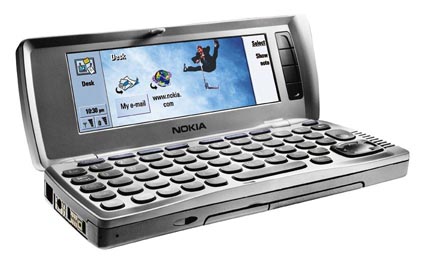
We'd had a one-box solution of sorts before, with the GeOS-powered 9110 Communicator a year or so before and the Ericsson R380, running an early form of Symbian OS, but neither of these could be extended in the way that the new 9210 could. Close on its heels we had the Handspring Treo 180, combining a Palm OS handheld and a phone, plus the Nokia 7650, taking the core Symbian OS and packaging it in a one-handed phone-like form factor. The key word here is 'extended', which leads to the very first definition of what constitutes a 'smartphone':
Definition 1: A smartphone can be extended through hundreds of add-on applications (that run on an equal footing with the core operating system)
Yes, yes, the concept of hundreds and thousands of 'apps' dates back into the Palm OS and Psion (EPOC) eras in the mid-1990s - apps aren't an invention of the Apple iPhone 3G, funnily enough... Here then, the 'smart' bit refers to the fact that you can increase the intelligence of your device by adding applications that cover other areas of functionality or which modify the behaviour of the interface to suit - everyone's 'smartphone' then becomes their own, to some extent, with customisation of the interface, of the applications and of their behaviour.
Definition 1 still applies today in many people's minds, including my own. And, importantly, it's the one used by the analysts who quote world sales figures. They may define smartphones as 'converged devices', but this doesn't really tell you anything - after all even the humblest feature phone can now play music, browse the web and take photos. Dig deeper and you'll find that it's this ability to extend operations with extra applications that's at the heart of what's considered a smartphone and what isn't.
There are two slight problems with definition 1. Firstly, it's so wide that it includes everything from the lowest S60 budget Symbian phone, at around £100 SIM-free in the UK, to the most expensive tablet Android devices or the iPhone 4G, up in the £600+ region. The width isn't a problem per se, but those who are fans of non-Symbian platforms automatically cry fowl when the official smartphone stats come out, since the higher sales of the £100 and £200 Symbian smartphones usually dominate sales of their top end high priced models. Secondly, even the humblest feature phones are extensible to a degree by adding Java (J2ME) applications and games - it's not quite the same as native apps and of course there's no multitasking, but end users won't necessarily understand this.
Definition 1b: A smartphone runs a proper (or 'open') operating system
Ostensibly linked to definition 1, in that add-on applications are only made possible by virtue of an extensible OS, this definition possibility falls down when networks or manufacturers use such an OS and then lock it down, usually for cost reasons (less things to go wrong for those pesky, fiddling users). Examples here are the top-end MOAP phones in Japan, running Symbian OS but un-expandable.
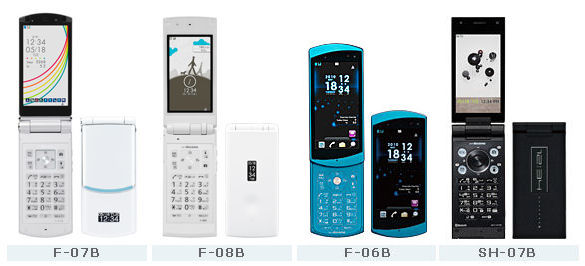
Some FOMA/MOAP 2010 phones from Japan, 2010. They run Symbian OS but are they 'smart'?
Definition 2: A smartphone is a mobile phone that offers more advanced computing ability and connectivity than a contemporary basic 'feature phone'.
That's Wikipedia's top level definition, at any rate, and it gels with a lot of popular perception. The idea is that smartphones are simply more advanced than traditional mobile phones, with higher specifications. The problem with this is that technology is always advancing and today's smartphone features, by this definition, will be tomorrow's feature phone err... features. As mentioned above, the simplest phones now play music, allow basic web browsing and email, include a decent camera, and so on. Those would have been the previous characteristics of a smartphone under definition 2.
I suppose you could always say that the top n% of phones, sorted by features, are smartphones and everything below them mustn't be 'smart', but this just feels weak and subjective.
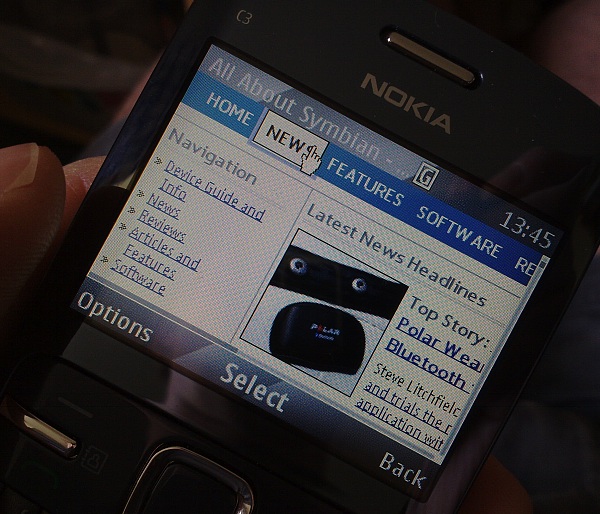
The Nokia C3: unashamedly not a smartphone, yet with Wi-Fi, music playback, email, multi-megapixel camera, QWERTY keyboard (see below) and web browsing
Definition 3: A smartphone has a physical QWERTY keyboard. Addendum: or a virtual QWERTY equivalent
This definition was beloved of Americans, hooked on Blackberrys, right up to the point when Apple brought out the iPhone. At which point the addendum had to be invoked. There's a decent correlation, in that many of the 'smartest' mobile devices do have either a hardware QWERTY keyboard or a large enough screen that a virtual version becomes practical. And, after all, with a QWERTY input system, you're going to be doing some serious interaction with the device, matching up nicely to the perception that you're a top end user doing 'smartphone' things.
However, you can now get QWERTY-equipped hardware for £50 in the shops (the C3 shown above is only £80), running distinctly lower-tier, locked down operating systems. In addition, all the cheaper touchscreen phones have a virtual QWERTY keyboard of sorts, even if it's often fairly small and unusable. In addition, you have a huge number of powerful, highly specced Symbian-based devices with just an 'old fashioned' numeric keypad. Of all the definitions of 'smartphone', the QWERTY version has, ultimately, the least validity in 2010.
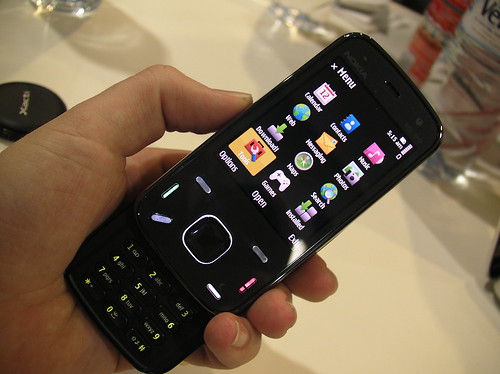
Nokia N86 8MP, one of the highest specced smartphones around yet small and with 'only' a numeric keypad for input
Definition 4: A smartphone has a touchscreen
Derived from the PDA days, carried on into the Windows Mobile 'XDA' era, and then revived with the iPhone, the idea is that touch unlocks extra functionality and interaction possibilities. While again most people would agree that there is a degree of correlation, it's plain that the number of budget touchscreen phones debunk this definition rather quickly.
Definition 4b: A smartphone has a large touchscreen. Where 'large' is defined as anything from 3.2" upwards
With the size caveat, this modified definition has a lot more validity and is, in effect, what a lot of the tech press really mean when they think of a smartphone. The vision is of a screen that's large enough to 'do' things, powerful things with. In terms of devices, there's the 3.5"-screened Apple iPhone range, a glut of Android-powered tablet phones with 3.7" to 4.3" screens, plus a lot of Symbian 'mid-tier' touchscreen devices (N97 mini, 5800, 5230, C6, X6, etc.) with 3.2" display.
While, in theory, a dumb feature phone could be made with a 3.2" or 3.5" screen, little has appeared so far - the screen is the single largest most expensive part in a phone and so a cheaper feature phone is thus crippled in terms of the hardware it can be specced with.
The biggest fly in the ointment here is the presence of the 'candybar QWERTY' form factor - the classic Blackberry and the Nokia E71/E72/E5, all of which are most definitely smartphones by anyone's standards (even Americans).
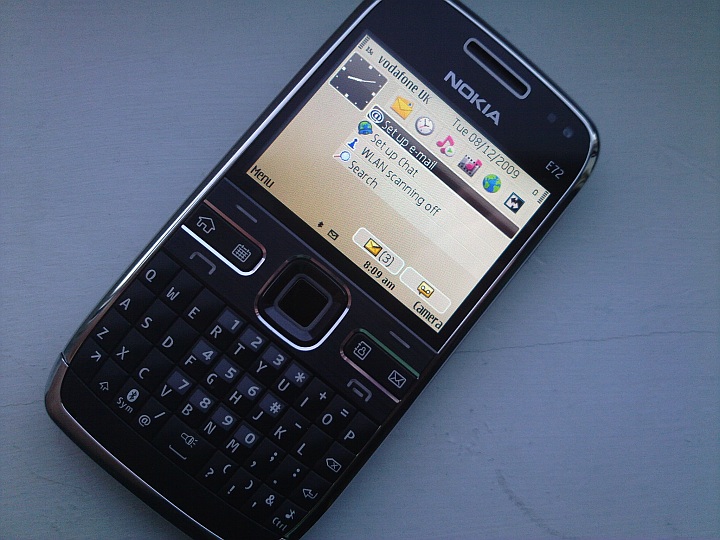
Nokia E72: no touchscreen, small 2.4" display - so not smart, then, according to definition 4?
Definition 5: A smartphone is always connected
This recent definition works pretty well. Although feature phones can go 'online', most of their functions will centre on apps built into the phone and on voice and texts. At most there might be a very basic Twitter or Facebook client. In contrast, a 'smartphone's default state is online, either over Wi-Fi (the presence of which almost makes for a definition in its own right) or over 3G or even 4G these days. Whether for social networking or push email or web browsing or news applications - or even online gaming - the presence of the Internet is ubiquitous.
Definition 5b: A smartphone is always connected and can browse the full Internet
Yet again we have a modified version of an existing definition that seems to be gaining more acceptance. In addition to other online functions, it seems to be a given now that when people talk about smartphones, they imply an ability to browse full web sites, which should appear just as they do in a desktop browser. It's a nice modification to the definition but doesn't really hold water. For example, the Apple iPhone (even the new version 4) doesn't 'do' Flash content, so many pages have a big Flash-sized hole in them, especially for non-YouTube videos. And complex Javascript in-page apps often struggle on phone browsers - the All About Symbian CMS uses heavy Javascript WYSIWYG editors and doesn't come close to working properly on any smartphone I've yet tried (or the Apple iPad, come to that). The Symbian browser has Flash Lite support, meaning that some Flash content is shown and videos often work as well - but then the whole browsing experience is limited by screen size and control mechanisms.
And that's leaving aside the thorny issue of whether the full, MB-per-page desktop browsing experience is even sensible on a phone, with data caps getting ever tighter as more and more people get online and want a share of the overall bandwidth. There's a lot to be said for smartphones being 'smart' about what version of a web site gets loaded and rendered. For example, pulling up a news story on the CNN or BBC web sites is far faster on the 'mobile' site (that gets served up automatically to many phones) than when forcing the phone to load the 'full' version.
_______________
So, we have five (or up to eight, if you count the amendments) major definitions of what constitutes a 'smartphone'. And they're all flawed to some degree. Is there a consensus in the industry for the term? No. Rafe's view is that the term itself is somewhat irrelevant, a conclusion I came to two years ago when I renamed The Smartphones Show to The Phones Show. The theory is that a phone is a 'phone' - at least that's what the man and woman in the High Street will call it.
However, having played with many low end phones over the last few months (from LG Cookies to Nokia Series 40 to Sony Ericsson Wseries devices), I've come to the conclusion that there's a still a wide gulf in terms of ability between these units and true 'smartphones'. The apps, the multitasking, the better browsers, the high specs, the larger screens - ALL of these factors make a smartphone smart. And so the term is still relevant, it's just singling out a definition that's the hard bit.
Here goes anyway, my tuppence worth from 2010:
A smartphone runs an open (to new apps) operating system and is permanently connected to the Internet.
I know a lot of American tech bloggers will cry foul - they'll say that it's preposterous for my little Nokia N86 to be considered in the same class as the HTC EVO 4G/Incredible/Droid X. But the Nokia fits the best definition I can come up with and, in truth, can do most of what its larger competition can. Going forward, calling these new 4"+ screened tablets should perhaps receive their own category - maybe 'superphone' wasn't a bad suggestion after all!
In part two of this feature, I'm going to take the aforementioned Nokia N86 and pitch it, in terms of recognised smartphone functionality, against one of the most popular and highest 'specced' Android phones being sold here in the UK, the HTC Desire. Will my definition hold water?
Steve Litchfield, All About Symbian, 18 July 2010
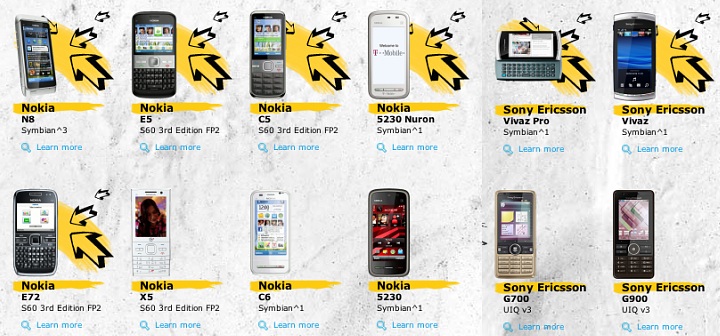
A selection of recent Symbian-powered smartphones...
